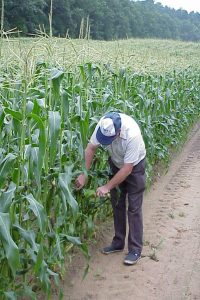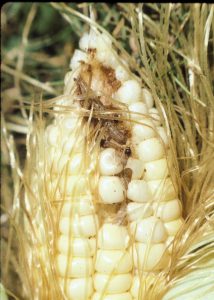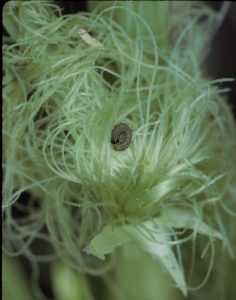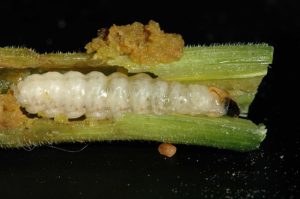Sweet Corn IPM Newsletter – No. 6 – July 29, 2022

CORN EARWORM, FALL ARMYWORM NUMBERS RISE
Silking corn in most locations now requires protection
SITUATION
Harvest of early corn continues in southern Maine. Showers have provided some drought relief in many locations, but seasonal rainfall is still well behind normal. Another predicted stretch of hot weather next will push corn maturity ahead. Moth counts of corn earworm, fall armyworm, and western bean cutworm were significantly higher at most locations this week, so sprays to protect silking corn have been recommended. Larval feeding damage on pre-tassel corn remains moderate, however, so non-silking corn has not required sprays.

European corn borer: Larval feeding injury was not over the 15% control threshold for pre-tassel corn at any of our scouting sites. Moth captures in pheromone traps were over the 5-moth threshold for silking corn at one Dayton site, one Lewiston site, and Monmouth. All of these sites are also on a spray interval for corn earworm, which should also provide protection against European corn borer.
Corn earworm: Moth counts have risen significantly in nearly all locations this week, and most silking fields now require protection against corn earworm. A 6-day spray interval for fresh silking corn was recommended at one Wells site. A 5-day spray schedule was recommended for Bowdoinham, Dayton, Garland, Monmouth, Oxford, and Wayne. A 4-day spray interval was recommended in Biddeford, Cape Elizabeth, New Gloucester, and one Wells site. All other sites were below threshold.

Fall armyworm: Fall armyworm activity increased this week, although distribution around the state is still spotty. Moth counts were over the three-moth threshold for silking corn in Biddeford, Cape Elizabeth, Dayton, New Gloucester, Oxford, and one Wells site. All of these sites are also on a spray interval for corn earworm, which should provide protection against fall armyworm. Larval feeding damage on leaves and tassels was found at several sites, but not over threshold.
Western Bean Cutworm: Moths were more widespread this week and were found in higher numbers at most locations. Moth counts ranged from 6 to 58, so growers should be prepared to protect any silking corn that is not under a spray interval for corn earworm. We have not yet found any larval feeding damage in the field.

Squash vine borer: Moths counts continue to be high this week, with numbers ranging from 7 to 20. With the threshold of 5 moths per week, this means that winter squash and pumpkin plantings should be protected against squash vine borer at this time. See the New England Vegetable Management Guide for control options.
Spotted wing drosophila alert: Traps counts were higher in some locations, but still quite variable from site to site. About half of our trapping sites are now over the control threshold of 6 or more SWD caught per week. We expect numbers to continue rising as the season progresses. For more information visit our website:
http://extension.umaine.edu/highmoor/news-events/.
Sincerely,
David T. Handley
Vegetable and Small Fruit Specialist
Highmoor Farm UMaine Extension Diagnostic
P.O. Box 179 Research Lab, Pest Mgmt. Unit
52 U.S. Route 202 17 Godfrey Drive
Monmouth, ME 04259 Orono, ME 04473
207.933.2100 1.800.287.027
Sweet Corn IPM Weekly Scouting Summary
| Location | CEW
Moths |
ECB
Moths |
FAW
Moths |
%Feeding
Damage |
Recommendations / Comments |
| Biddeford | 18 | 0 | 10 | 12% | 4-day spray interval for silking corn |
| Bowdoinham | 6 | 0 | 0 | 1% | 5-day spray interval for silking corn |
| Cape Elizabeth | 18 | 0 | 10 | 1% | 4-day spray interval for silking corn |
| Dayton I | 5 | 6 | 4 | 0% | 5-day spray interval for silking corn |
| Dayton II | 5 | 0 | 3 | 5% | 5-day spray interval for silking corn |
| Farmington | 1 | 0 | 1 | 2% | No spray recommended |
| Garland | 4 | 0 | 1 | 0% | 5-day spray interval for silking corn |
| Lewiston | 7 | 5 | 0 | 1% | 5-day spray interval for silking corn |
| Lewiston II | 5 | 1 | 0 | 0% | 5-day spray interval for silking corn |
| Monmouth | 4 | 9 | 0 | 3% | No spray recommended (No silking corn) |
| New Gloucester | 9 | 1 | 12 | 0% | 4-day spray interval for silking corn |
| Oxford | 4 | 3 | 3 | 0% | 5-day spray interval for silking corn |
| Palmyra | 1 | 0 | 0 | 0% | No spray recommended |
| Sabattus | 0 | 0 | 1 | 2% | No spray recommended |
| Wayne | 4 | 0 | 0 | 0% | 5-day spray interval for silking corn |
| Wells I | 2 | 1 | 7 | 0% | 6-day spray interval for silking corn |
| Wells II | 28 | 1 | 2 | 0% | 4-day spray interval for silking corn |
CEW: Corn earworm (Only fresh silking corn should be sprayed for this insect.)
ECB: European corn borer
FAW: Fall armyworm
| European Corn Borer Thresholds
Whorl stage: 30% or more of plants scouted show injury. Pre-tassel-silk: 15% or more of plants scouted show injury. Silk: 5 or more moths caught in pheromone traps in one week. |
Corn Earworm Spray Thresholds for Pheromone Traps
| Moths caught per week | Moths caught per night | Spray interval |
| 0.0 to 1.4 | 0.0 to 0.2 | No spray |
| 1.5 to 3.5 | 0.3 to 0.5 | Spray every 6 days |
| 3.6 to 7.0 | 0.6 to 1.0 | Spray every 5 days |
| 7.1 to 91 | 1.1 to 13.0 | Spray every 4 days |
| More than 91 | More than 13 | Spray every 3 days |
Thresholds apply only to corn with exposed fresh silk. Lengthen spray intervals by
one day if maximum daily temperature is less than 80°F.
IPM Web Pages:
http://extension.umaine.edu/ipm/
http://www.pestwatch.psu.edu/sweet_corn.htm
https://ag.umass.edu/integrated-pest-management/
Where brand names or company names are used, it is for the reader’s information. No endorsement is implied nor is any discrimination intended against other products with similar ingredients. Always consult product labels for rates, application instructions and safety precautions. Users of these products assume all associated risks.
The University of Maine is an equal opportunity/affirmative action institution.
